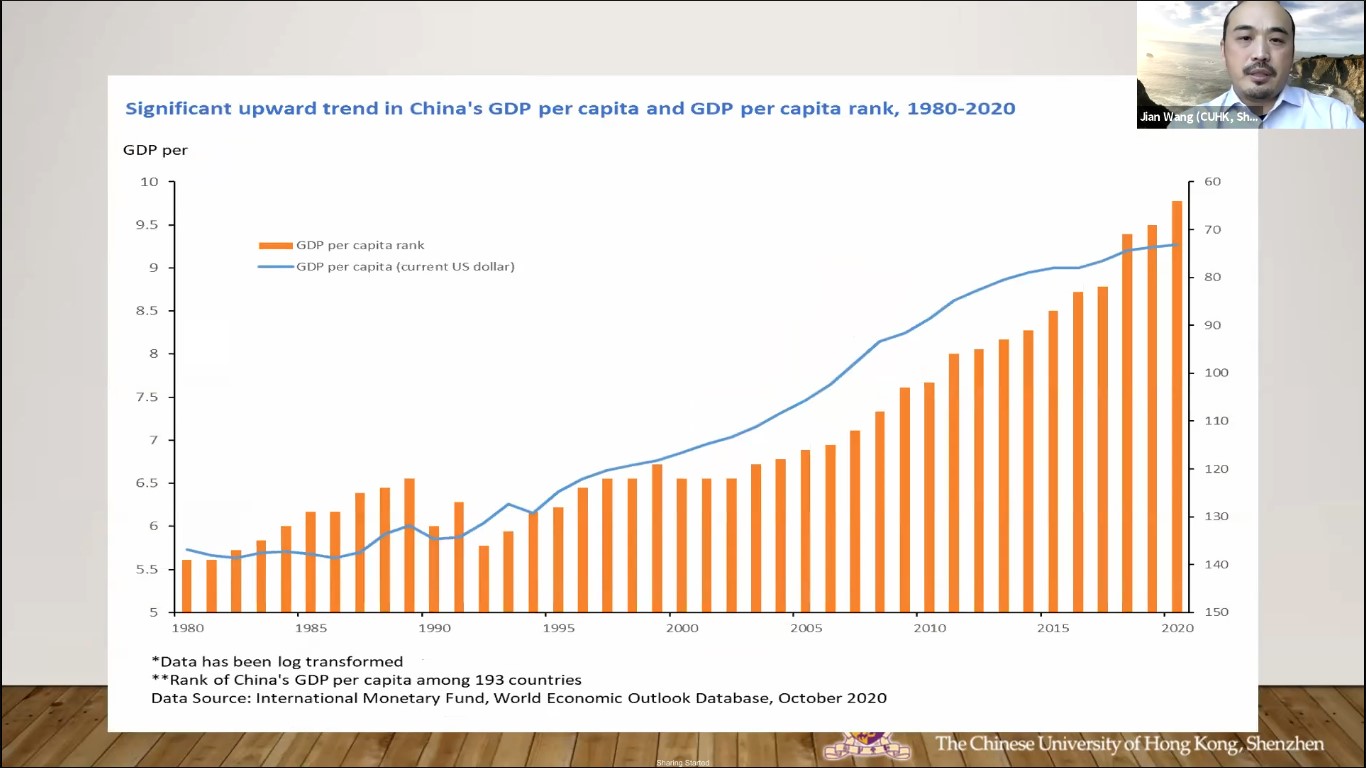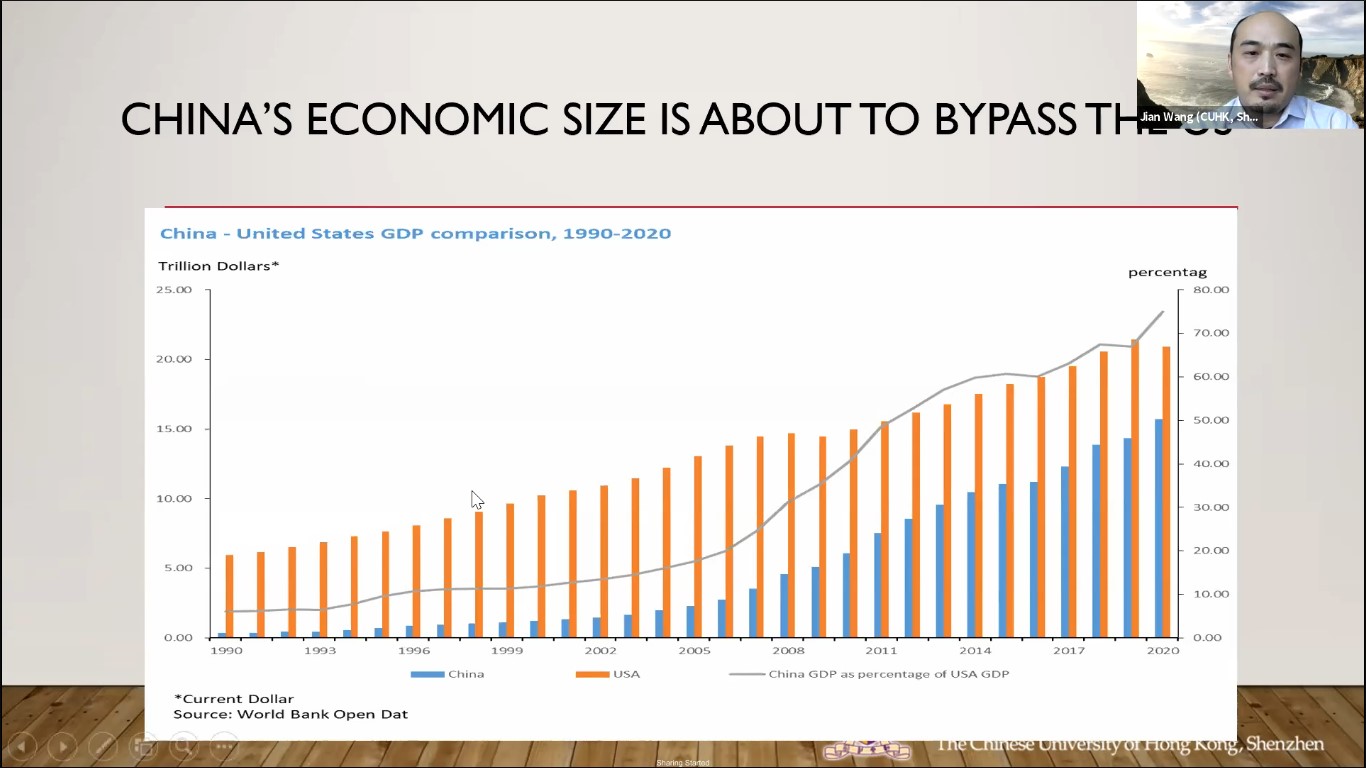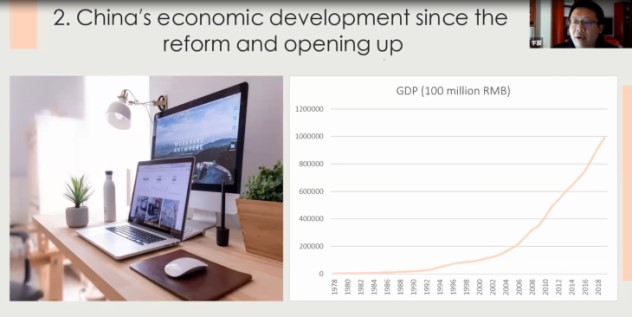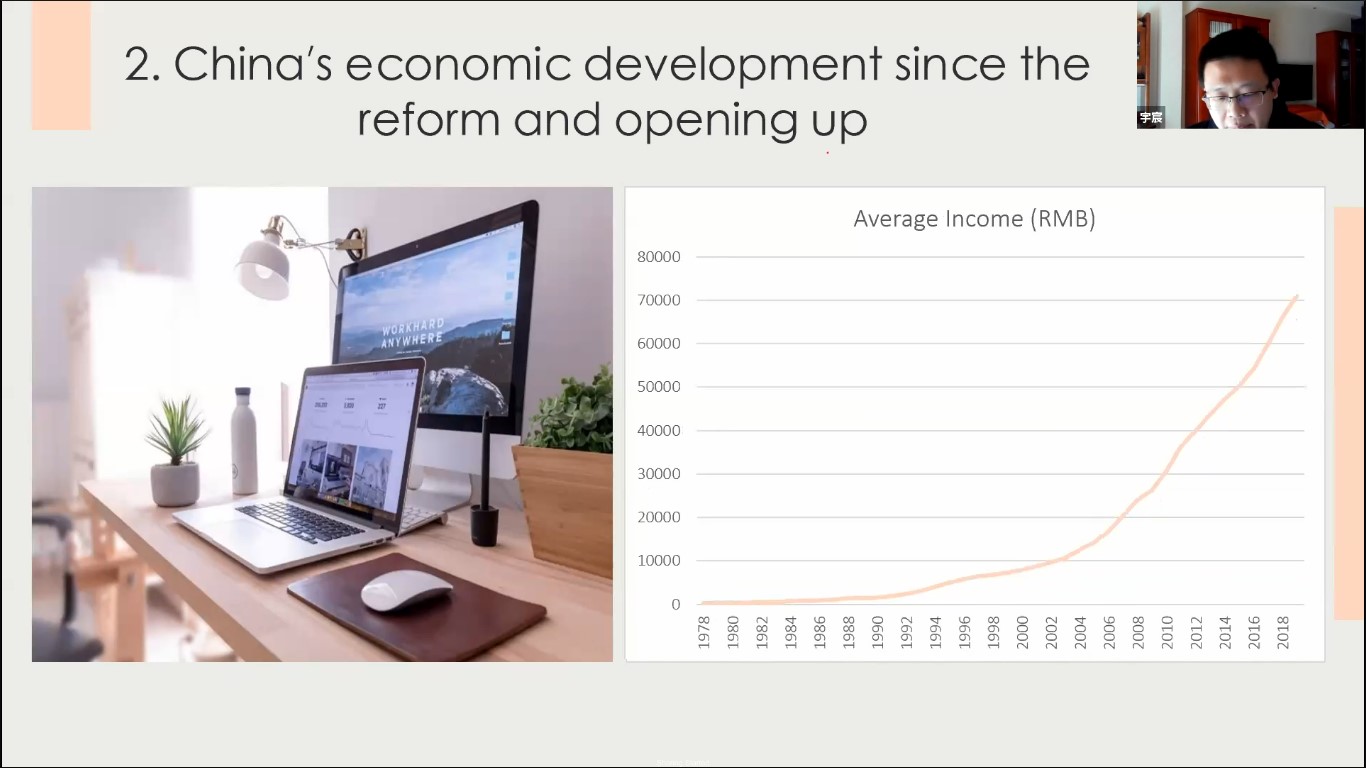
With the aim to share the knowledge of the development of China's economy,
its impact as well as the opportunities and challenges in the domestic and
international markets, two webinars titled “China in the World Economy:
Opportunities and Challenges” and “The Development of China's Economy” were
jointly organised by
UTAR
Institute of Management and Leadership
Development (IMLD), Division
of Community and International Networking (DCInterNet) and China-ASEAN
Institute of Financial Cooperation (CAIFC) on 2 March 2021 via ZOOM.
It was moderated by IMLD Director Prof Dr Cheng Ming Yu.
Invited to be the speaker for the first session was The Chinese University
of Hong Kong (CUHK), Shenzhen School of Management and Economics Assistant
Dean (Academic)-cum- Shenzhen Finance Institute Director of Centre for
Macro-Financial Stability and Innovation Prof Wang Jian. He is also the Special-Term Professor of CAIFC, Guangxi University. Before joining
CUHK, Shenzhen, he worked as a senior research economist and advisor at the
Federal Reserve Bank of Dallas from 2006 to 2016. His research interest
included international finance, behavioural finance/economics, international
macroeconomics, and monetary economics. He is also an editorial board member
of the Pacific Economic Review. He has written several articles in top tier
journals.
The speaker for the second session was Head of Department of Financial
Engineering Dr Yu Chen from the Business School of Heze University, China.
He holds a PhD in Economics at the University of Cyprus in 2017. His
research areas included Applied Econometrics, Economics and Economic
History. He was an excellent instructor at the national Internet finance
innovation competition; his two papers on economic history have won the
first prize in China.

Prof Cheng welcoming the participants
Welcoming the participants to the webinars, Prof Cheng said, “As one of the
fastest-growing economies in the world, China has achieved remarkable
economic development since it reformed and opened up in 1979. China is
playing a growing role in the world economy. The status of China’s economy
in global economy has changed dramatically. China has expanded its
international economic activities particularly in trade investment and has
deep integration in the global economy, global production network and supply
chain.”

Prof Wang

Prof Wang recommended two books that will especially benefit MBA students in
understanding how the financial market works
During the presentation, Prof Wang shared public views and opinions
regarding the western world against China. He said, “Before 2008, people
were very suspicious, most people predicted that China was about to
collapse. At that moment, people argued that China’s economic growth was
mainly driven by investment. The government made a lot of investments to
create jobs and stimulate economic growth, but the growth was not
sustainable. Some people even
thought that the government had faked the data; that China’s GDP did not
grow that fast. Some people also thought that China’s economy was driven by
some bubble, like the housing bubble. So these were the many bias opinions
about China’s economy.”


China’s economic growth in the last 40 years
“But after 2008, when more people understood the real living standard of
China, they stopped questioning China’s economic achievement. However, they
began questioning why China was becoming more successful compared to many
other countries including the United States (U.S.). There were complaints
about China on its corruptions, political system and pollution. So, even if
China has achieved the living standard at one point to show its huge
economic achievement, there were still a lot of misunderstanding about
China’s economic miracle,” said Prof Wang. He then shared a couple of videos
and explained the changing of public views regarding China. He continued,
“Right now, not only the general public but also the economists have become
less cynical; many of the economists have started to spend more time and
effort thinking about what China did right rather than what did wrong. One
of the important changes in the view or attitude is the role of government
in the economic growth.”
“But China also faced a lot of challenges, especially in keeping up with its domestic economic miracle. Even if we acknowledged the importance of government in the economic growth, we still need to have a balance between the government’s role and the private sector; also how to improve the government’s efficiency and legal system, reform areas such as financial markets and transform economy from labour-intensive manufacturing sector to innovation-driven. In any way, we believe China is going to play an increasingly important role in the regional and the global economy. One of the examples is the Great Bay Area (GBA) and another example is the Belt and Road Initiative (BRI). These are very important opportunities for China to develop but China needs to deal with some massive challenges along the way,” said Prof Wang.

After the State-Owned Enterprises (SOE) reform in the 1990s, the profit margin of SOE increased dramatically, contributing to China’s economic success

“Dealing with China” revealed the challenges that China was facing and how it solved the problems

The GBA
He then continued, “One of the challenges or bottleneck that is faced by
China’s economy is high costs due to market segregation. China has a very
strong political power under the central government, but the market is kind
of localised. This is the exact opposite compared to the U.S. In the U.S.,
the federal government has very limited power, but the whole market is
unified across the country.”
“The same issues also exist in the GBA. In GBA, we have three legal systems,
three currencies and three tax systems, namely Mainland China, Hong Kong and
Macau. Also, the low labour mobility and the imbalances of economic
development issue. Hence, if we are able to find some way to solve these
problems in the GBA, we can push the policies to some other places in China
to help increase the regional and the global influence and also sustainable
economic growth,” he added.
Sharing on the future direction of GBA and its recent development, he said,
“For the future direction, the whole idea for the GBA is called
‘Interconnection’, which includes the free flow of goods, labour and
capital. We want to build a unified market for goods, labour and also for
capital flows.”
“We have done several projects including the cross-border mobile payment— for example, Wechat pay and the cross-border financial products and services— for example, insurance and the identification for GBA residents. Hopefully, we will have this E-pass using facial recognition and Artificial intelligence (AI) technology to reduce the cost for people travelling from one area to another. In addition is the blockchain for trade and financing. If we are able to build this blockchain in Hong Kong, Shenzhen and maybe later in Shanghai, Indonesia, Malaysia and other trading partner countries of China, we can connect them together. We can share more information; we can get better international trade and better financial services. So these are very promising, a development happening in the GBA. I believe this definitely will not only affect the regional economy in the future, but also Asia and a few countries that are doing trade with China. I also believe it has substantial global influence for China,” said Prof Wang.

Dr Yu
Dr Yu Chen, on the other hand, began his presentation with the history of
China to better understand China’s economy. He introduced a system called
the “Square-fields system”. It was the earliest socio-economic system in
China that can be found in the historical literature. It first appeared in
the Western Zhou Dynasty between 1046 B.C. to 771 B.C.
“After the collapse of the square-fields system, the “Tax per mu
system” appeared in China. It acknowledged the legalisation of land
privatisation which lasted for almost two thousand years in China. The land
was given to the slaves and peasants were free to farm; the output belonged
to them as long as they submit their taxes. Soon, China entered into the
stage of feudalism when the people worked hard enough and got richer. Since
the foundation of the People’s Republic of China on 1 October 1949, the
ownership right of the land returned to the country and the people,” said Dr
Yu.
“During the Third Plenary Session of the Eleventh Central Committee in
December 1978, the Party Central Committee proposed the implementation of
internal reform and opened up to the outside world which became China’s
basic national policy. Since then, the economy of China developed rapidly,
and people’s lives underwent earth-shaking changes which attracted worldwide
attention. China became the
second-largest economy in the world. The per capita income increased from
385RMB in 1978 to 70,892RMB in 2019, with an average annual growth rate of
13.6 per cent. China’s economy ran smoothly in 2019. The GDP reached 99.1 trillion
RMB, an increase of 6.1 per cent. A total of 13.52 million new jobs was created in
the cities and towns, and the unemployment rate was lower than 5.3 per cent.
The consumer price index rose by 2.9 per cent and the balance of payments was
balanced,” said Dr Yu Chen.


Figures show the growth of China GDP and per capita income since the reform
and opening-up
While bringing up the topic of BRI, Dr Yu introduced two prominent
historical figures, namely Zhang Qian and Zheng He, who have a far-reaching
influence on the BRI. “The BRI, also known as the One Belt and One Road
Initiative (OBOR), was proposed by China’s President
Xi Jinping
in 2013. It is a development strategy that focuses on connectivity and
cooperation between Eurasian countries. It is short for the Silk Road
Economic Belt (based on the ancient Silk Road discovered by Zhang Qian) and
the 21st-century Maritime Silk Road (based on the maritime Silk Road
discovered by Zheng He). The Silk Road economic belt is also referred to as
“One Belt” in short. It aims to develop an economic partnership between
China and countries along the land silk road. The 21st-Century Maritime Silk
Road was referred to as “One Road” in short. It is the economic cooperation
between China and Southeast Asia, South Asia, the Middle East, North Africa
and Europe along the maritime silk road,” said Dr Yu.
“Until November 2020, China has signed 201 copies of cooperation contracts
with 138 countries and 31 international organisations. The nations along the
BRI have enjoyed great benefits and the multitudes of opportunities have
brought them wealth,” he added. Meanwhile, he also shared with the
participants on the Sino-US trade conflicts.
Sharing China’s economy in the context of the sudden outbreak of the
Coronavirus last year, Dr Yu said, “China’s economy has suffered great
loses. According to the National Bureau of Statistics of China, China’s GDP
in the first quarter of 2020 was 20.6 trillion RMB, which is 25.7 per cent
lower than that in the fourth quarter of 2019. The growth rate of fixed
assets investment in February 2020 was -24.5 per cent and -16.1 per cent in
March 2020. Compared to January 2020, China’s total trade volume decreased
by 11 per cent in February 2020. Fortunately, the pandemic was controlled from the
end of March to the beginning of April 2020. All the industries were
gradually returning to work and production. China’s economy then recovered
rapidly with its GDP growth rates reaching 21 per cent, 6 per cent and 12
per cent in the second, third and fourth quarters respectively.”
He then continued, “The prosperity of China’s economy has brought many good
opportunities to enterprises of various countries. Taking China and ASEAN
countries as an example, China and ASEAN countries are important strategic
partners for the development of their economic and trade cooperation. Under
the context of coronavirus pandemic, trade between China and ASEAN countries
has made brilliant achievements showing the tenacity of bilateral economic
and trade relations. The three sectors in China, namely agriculture,
manufacturing and the service sector are well balanced. There are huge
potential and bright prospect in economic cooperation between China and
ASEAN countries in these three sectors.”
He then concluded his presentation by sharing the challenges and
countermeasures of China’s economic development. He said, “The cooperation
between China and ASEAN requires knowledge and understanding of each other’s
languages, culture and law to deepen bilateral cooperation. It is an
important challenge to the cooperation between the Chinese government and
ASEAN governments as well as the enterprises.”
The webinars concluded with interactive Q&A sessions and group photo sessions. Besides UTAR staff and students, the webinars also received participation from Guangxi University and the Heze University of China.

Prof Cheng (top
row, second from left) and Prof Wang (top row, second from right) with
participants
.jpg)
Dr Yu (top row,
second from left) and Prof Cheng (top row, most right) with participants
Wholly owned by UTAR Education Foundation Co. No. 578227-M LEGAL STATEMENT TERM OF USAGE PRIVACY NOTICE